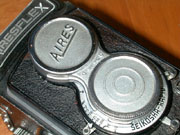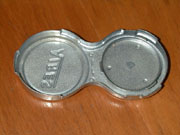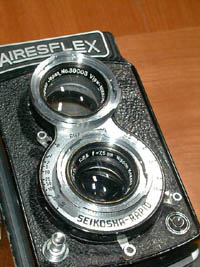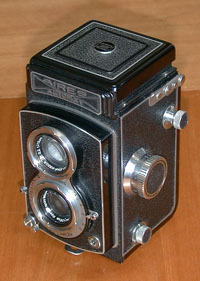Airesflex
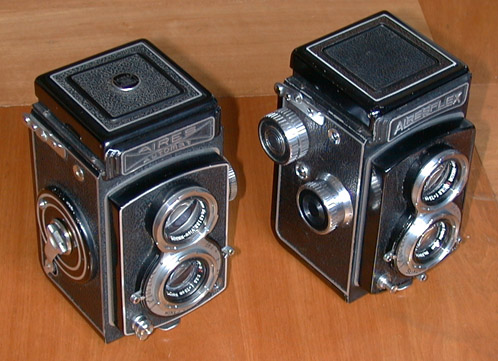
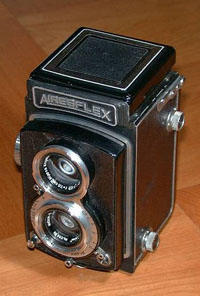
|
Around 1950, just after the world war II, medium format TLR (Twin Lens Reflex) type cameras became much popular in Japan. It is said that every initial letter except J, U, X are covered by TLR names manufactured in Japan. But however, the TLR camera came with Nikkor lens was the Airesflex, only. Aires Camera Works co. was established from its past Yallu Optics which is famous for unique design TLR named Yalluflex. After that, they made the Airesflex model-Y which design was originated from Rolleicord in August 1950. Then, the engineer Mitsuhashi seeked for giving uniqueness to the camera, because many similar TLRs were sold in Japan as described above. Fortunatelly, Aires Camera had a connection with Nippon Kogaku and proceeded to adopt Nikkor smoothly because Mitsuhashi was employed by Nippon Kogaku while WW-II. In 1951, Airesflex model-Z with Nikkor lens was put on sale. On the occasion of supplying Nikkor lens, it is said that Nippon Kogaku requested Aires Camera to adjust their quality control level such as focus precision to the standard of Nippon Kogaku. But Nippon Kogaku could not supply enough number of the lens because of the shotage of optical glass. For instance, they had already stopped supplying lens in 1948 to Canon who was the first customer of Nikkor lens for Hansa-Canon camera. For that reason, some variations of Airesflex-Z were sold with the other lens, such as Olympus Zuiko or Showa Koki Coral. Airesflex-Z was evolved to Airesflex Automat with self-cocking and double-exposure prevention mechanism. This camera is well manufactured and more useful with crank winding.But the shotage of the lens was not improved and Aires Camera bought lens department of Showa Koki. After that, Aires Camera had made varied types of camera such as rangefinder with Coral lens, but Nikkor had been never used for their camera. The camera shown right-above is Airesflex model-Z. This type is very similar to Rolleicord type-III, and film-winding and focusing knob is brougnt together to right-hand side. The left-hand mainly holds the camera, and charge and release the shutter. That operation is suit for handy shoot. The successor Airesflex Automat had changed to crank-winding by the right hand and the focusing knob was moved to left-hand side. This type is useful for shooting on tripod. The film is set at the bottom of the camera and wound to above, as Rolleicord. The first frame is not set by red-window but set by using start-mark, and then you must close the back-door, reset the film counter, and wind-up and the first frame is in the right position. After you shoot, press the button on the center of wind-up knob to release the winding-lock, and wind. Double-exposure prevetion mechanism is not included. The camera shown left is Aires Automat. Film winding is changed to crank instead of knob, and shutter is charged simultaneously. No shutter charge lever below the lens. Such function make it possible to concentrate to taking photo without the nuisance of unwilled double-exposure or winding-up without exposure. Film loading procedure is start-mark style without sensing the thickness of the film as rolleiflex (so-called semi-automat). Focus dial is at the left hand and the minimum focus distance is shortened from 90cm to 80cm. Frame counter is reseted when the back door is opened (A trigger lever to reset the counter is at the side of exposure gate.) Shutter button accepts usual release cable (Z type requires Leica-type release). Synchro connector is also standard type as usual cameras. Shutter is as same as Z-type, SEIKOSHA RAPID, but both shutter speed and aperture lever have now clicks. Because of the TLR style, it has two lens, taking and view lens. Of course, The view-lens is also Nikkor, "That will kill two birds with one stone". The taking lens is NIKKOR-Q.C 7.5cm F3.5. The marking "C" means not multi-coating as Nikkor-Auto lens or Bronica-Nikkor, but it means "just coated" as Nikkor for range-finder Nikon. The view-lens is View-NIKKOR C 7.5cm F3.2 which is a little faster than taking lens for ease of fine focus adjustment. The other distinctive point of the lens is the letter face of the marking. The letter "a" and "g" is different from the one on later lens. |
Lens for Airesflex
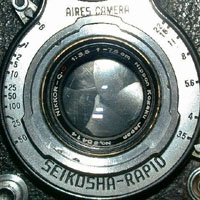 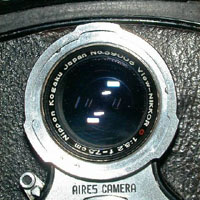
|
The taking lens is tessar-type, but the original design is not known, because the lens for Hansa-Canon 5cm F3.5 is designed for focal-plane shutter camera. Also the Nippon Kogaku TLR camera that planned with Nikon I simultaneously (that plan had been cancelled because of the difficulty of manufacturing leaf-shutter) would be equipped with 80mm F3.5 lens. In any case, the tessar-type lens is very simple and Nippon Kogaku was familier to it, and it might be easy to meet the request from Aires Camera. The result of shooting test showed very Nikkor-taste, high-contrast and sharp images. The sharpness of the center is only little changed by varying stops and it is hard to find the difference of the center of the image with ISO-100 color reversal film and 30x loupe. However, the corner is a little inferior to the center at wide-open. It is not seems to be caused by flare but the character of the tessar-type, field curvature and astigmasm. In any case, the 120 film has the trail-paper which causes tye bad flatness, so the field-flatness of the lens is not problem. Consequently, the lens is very well-designed and smart as the present lens.sample image The view-lens seems to be triplet, but also it is not poor, enough sharp and it is easy to adjust the focus precisely. It would be prior to the center, but I am willing to test the lens to see the fine image of the lens..
|
Specifications of Airesflex
Common in all Airesflex- film : type 120, 6cm x 6cm format, 12 frames
- wind up : adjust start-mark, auto stop
- finder : waist-level, glass-mat field with vertical and horizontal line
- taking lens : NIKKOR-Q.C 7.5cm F3.5
- viewing lens : View-NIKKOR 7.5cm F3.2
- finder-hood : one-touch open and close, with loupe, ability to see-through eye-level
Airesflex has some versions with Coral or Zuiko lenses. - shutter : seikosha rapid, B, 1 to 1/500sec, 10 leaves stop
- filter/hood atachment : same as early F3.5 Rolleiflex / Rolleicord, Bayonet 1
- film wind up : knob, film counter is reseted manually
- shutter : manual charge, not coupled with body
- release cable : covering type connecter (same as Leica or Nikon S)
- Synchro connector : special shape
- minimum focus distance : 90cm
- weight : 940g
- film wind up : clank, \film counter is reseted automatically when the back door is opened
- shutter : self cocking. shutter botton can be locked for Time exposure
- release cable : usual tapered thread
- Synchro connector : usual standard shape
- minimum focus distance : 80cm
- weight : 1040g

Accessory of Airesflex
